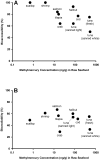Bioaccessibility and bioavailability of methylmercury from seafood commonly consumed in North America: In vitro and epidemiological studies
- PMID: 26896323
- PMCID: PMC4907874
- DOI: 10.1016/j.envres.2016.02.013
Bioaccessibility and bioavailability of methylmercury from seafood commonly consumed in North America: In vitro and epidemiological studies
Abstract
Methylmercury (MeHg) is a global contaminant of concern and human exposures are largely realized via seafood consumption. While it is assumed that 95-100% of the ingested MeHg from seafood reaches systemic circulation, recent in vitro studies have yielded results to suggest otherwise. Of the published studies to have characterized the bioaccessibility or bioavailability of MeHg from seafood, only a handful of seafood species have been characterized, there exists tremendous variability in data within and across species, few species of relevance to North America have been studied, and none of the in vitro studies have adapted results to an epidemiology study. The objective of the current study was two-fold: (a) to characterize in vitro MeHg bioaccessibility and bioavailability from ten commonly consumed types of seafood in North America; and (b) to apply the bioaccessibility and bioavailability data from the in vitro study to an existing human MeHg exposure assessment study. Raw seafood samples (cod, crab, halibut, salmon, scallop, shrimp, tilapia, and three tuna types: canned light, canned white, fresh) were purchased in Montreal and their MeHg concentrations generally overlapped with values reported elsewhere. The bioaccessibility of MeHg from these samples ranged from 50.1±19.2 (canned white tuna) to 100% (shrimp and scallop) of the amount measured in the raw undigested sample. The bioavailability of MeHg from these samples ranged from 29.3±10.4 (crab) to 67.4±9.7% (salmon) of the value measured in the raw undigested sample. There were significant correlations between the initial MeHg concentration in seafood with the percent of that Hg that was bioaccessible (r=-0.476) and bioavailable (r=-0.294). When the in vitro data were applied to an existing MeHg exposure assessment study, the estimated amount of MeHg absorbed into systemic circulation decreased by 25% and 42% when considering bioaccessibility and bioavailability, respectively. When the in vitro data were integrated into a regression model relating dietary MeHg intake from seafood with hair and blood Hg biomarkers, there were no differences in key model parameters when comparing the default model (that assumes 100% bioavailability) with models adjusted for the in vitro bioaccessibility and bioavailability data. In conclusion this work adds to a growing number of studies that together suggest that MeHg bioavailability from seafood may be less than 100%, but also documents the challenges when integrating such in vitro data into human exposure and risk assessments.
Keywords: Bioavailability; Biological availability; Caco-2 cells; Diet; Fish; Hg; Mercury; Risk assessment; Shellfish.
Copyright © 2016 Elsevier Inc. All rights reserved.
Conflict of interest statement
No conflict of interest is declared.
Figures


Similar articles
-
A Review of Mercury Bioavailability in Humans and Fish.Int J Environ Res Public Health. 2017 Feb 10;14(2):169. doi: 10.3390/ijerph14020169. Int J Environ Res Public Health. 2017. PMID: 28208586 Free PMC article. Review.
-
Benefits and risks associated with consumption of raw, cooked, and canned tuna (Thunnus spp.) based on the bioaccessibility of selenium and methylmercury.Environ Res. 2015 Nov;143(Pt B):130-7. doi: 10.1016/j.envres.2015.04.019. Epub 2015 May 8. Environ Res. 2015. PMID: 25962922
-
Factors affecting the bioaccessibility of methylmercury in several marine fish species.J Agric Food Chem. 2011 Jul 13;59(13):7155-62. doi: 10.1021/jf201424g. Epub 2011 Jun 20. J Agric Food Chem. 2011. PMID: 21650469
-
Decadal Changes in the Edible Supply of Seafood and Methylmercury Exposure in the United States.Environ Health Perspect. 2018 Jan 16;126(1):017006. doi: 10.1289/EHP2644. Environ Health Perspect. 2018. PMID: 29342451 Free PMC article.
-
Comprehensive review on in vitro bioaccessibility of mercury in various foodstuffs.J Hazard Mater. 2025 Jul 15;492:138136. doi: 10.1016/j.jhazmat.2025.138136. Epub 2025 Apr 1. J Hazard Mater. 2025. PMID: 40199075 Review.
Cited by
-
Effects of cooking methods and co-ingested foods on mercury bioaccessibility in pontic shad (Alosa immaculata).Curr Res Food Sci. 2023 Sep 20;7:100599. doi: 10.1016/j.crfs.2023.100599. eCollection 2023. Curr Res Food Sci. 2023. PMID: 37790855 Free PMC article.
-
Development and application of a novel method to characterize methylmercury exposure in newborns using dried blood spots.Environ Res. 2017 Nov;159:276-282. doi: 10.1016/j.envres.2017.08.021. Epub 2017 Aug 18. Environ Res. 2017. PMID: 28825981 Free PMC article.
-
Study of Factors Influencing the Oral Bioaccessibility of Commonly Used and Detected Pesticides in Bananas and Mangoes Based on in vitro Methods.Foods. 2024 Jun 26;13(13):2019. doi: 10.3390/foods13132019. Foods. 2024. PMID: 38998525 Free PMC article.
-
Effects of Speciation, Cooking and Changes in Bioaccessibility on Methylmercury Exposure Assessment for Contrasting Diets of Fish and Marine Mammals.Int J Environ Res Public Health. 2021 Mar 4;18(5):2565. doi: 10.3390/ijerph18052565. Int J Environ Res Public Health. 2021. PMID: 33806562 Free PMC article.
-
A Review of Mercury Bioavailability in Humans and Fish.Int J Environ Res Public Health. 2017 Feb 10;14(2):169. doi: 10.3390/ijerph14020169. Int J Environ Res Public Health. 2017. PMID: 28208586 Free PMC article. Review.
References
-
- Aberg B, Ekman L, Falk R, Greitz U, Persson G, Snihs JO. Metabolism of methyl mercury compounds in man: excretion and distribution. Archives of Environmental Health - An International Journal. 1969;19:478–484. - PubMed
-
- Afonso C, Costa S, Cardoso C, Oliveira R, Lourenço H, Viula A, et al. Nunes M. Benefits and risks associated with consumption of raw, cooked, and canned tuna (Thunnus spp.) based on the bioaccessibility of seleniuand methylmercury. Environ Res 2015 - PubMed
-
- Berntssen MH, Hylland K, Lundebye AK, Julshamn K. Higher faecal excretion and lower tissue accumulation of mercury in Wistar rats from contaminated fish than from methylmercury chloride added to fish. Food and Chemical Toxicology. 2004;42:1359–1366. - PubMed
-
- Cabanero AI, Madrid Y, Camara C. Selenium and mercury bioaccessibility in fish samples: an in vitro digestion method. Analytica Chimica Acta. 2004;526:51–61.
Publication types
MeSH terms
Substances
Grants and funding
LinkOut - more resources
Full Text Sources
Other Literature Sources
Medical

